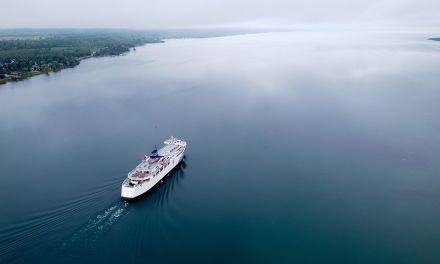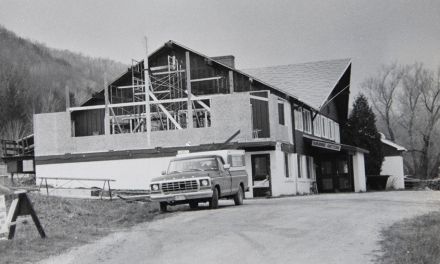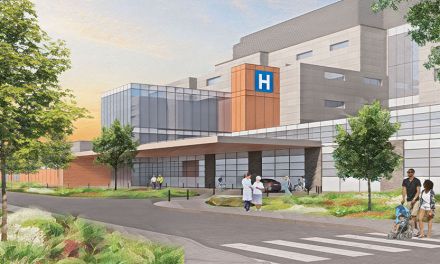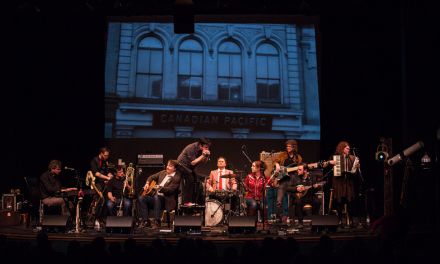
In the 1940s, visiting skiers arriving by train at the little station in Craigleith had to make a challenging, uphill trek to the bottom of the tows, either by climbing or by hopping on a horse-drawn sleigh for a small fee. Early trails were established on Schuss, and Khandahar at the north end and ‘O Hill’ on the south side. “It takes its name from the large letter once painted on the lime- stone crest of the escarpment, flanked by an ‘L’ on each adjacent promontory. Together the three letters LOL announced the Loyal Orange Lodge far out into Georgian Bay. They identify the men’s society of Protestant Irish origin that came with Irish immigrants to Canada in the 1830s.”
~ Looking for Old Ontario: Two Centuries of Landscape Change By Thomas F. McIlwraith
Snow covered hills have always been a lure, attracting all ages to slide. In the 1930s, pioneers in the fledgling sport of skiing began flocking to the Escarpment slopes near—what was then a ship building town—Collingwood. They began by climbing up and skiing down the hills at the north end of what is now Blue Mountain Resort. (The name Blue Mountains was first used by Charles Rankin when he started surveying the land on the south shore of Nottawasaga Bay in 1833).
The Blue Mountain Ski Club (BMSC) was formed by a group of local ski enthusiasts in 1935. The Toronto Ski Club (TSC), which was formed in 1924, was the leader in organizing trips to this area. These two clubs worked closely together and by1941 they had installed two rope tows, a sleigh tow called The Red Devil, and a log clubhouse.
Born in Czechoslovakia in 1909, Jozo Weider was a smart, energetic risk-taker, with an uncanny eye for business opportunities. Skiing since he could walk, he built his own chalet/home in the Carpathian mountains range where throughout the 1930s, he would house as many as 40 guests, act as a ski and climbing guide and even entertain them—he was quite adept with the accordian.
In 1939, Jozo, his wife Helen and their first child, George emigrated to Canada—escaping the Nazis. After a short stay in BC and then in Quebec, the family arrived in the Blue Mountain area in the spring of 1941at the invitation of Peter Campbell (later to become Senator Campbell). Campbell, who met Jozo while on a ski holiday in Quebec, was instantly impressed with Jozo’s ideas, personality and work ethic and offered him financial backing. The two partnered to form Blue Mountain Resorts Limited later that year, acquiring nine acres of land from TSC and BMSC in order to build a ski lodge. With a salary that covered living expenses along with a 25-percent share of the company’s profits, Jozo was employed as a ski instructor and sports director. And so began Jozo’s remarkable tenure that saw the development of Blue Mountain Resorts.
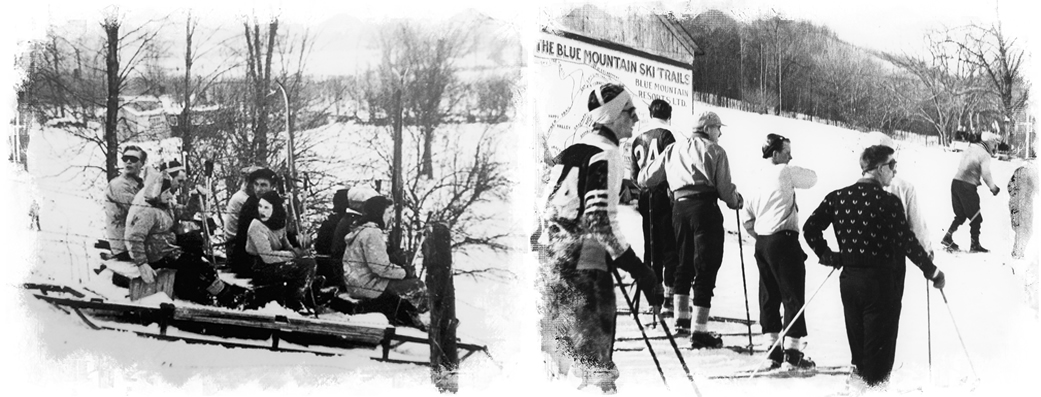
The ‘Red Devil’—a somewhat unreliable nine-passenger sleigh pulled by a ropetow, was installed on the Schuss in 1937 and operated for close to 20 years. It had been improvised by some crafty members of the original Blue Mountain Ski Club including Norman Boadway and Fred Loosli. The two- sleigh system—one that carried skiers up and another that returned to the bottom empty—was later replaced by a ‘pull lift’ consisting of several poles with discs at the end that skiers would put between their legs to be pulled up to the top of the run.
L – 1942 Skiiers access trails aborad the Red Devil | R – Racers ready at Blue Mountain Ski Trails
Courtesy: the Craigleith Heritage Depot, Blue Mountains Public Library.
The impact that Blue Mountain Resorts has had on this region is immeasurable and there are countless stories and memories from ‘back in the day’. We spoke with four skiers who rode the original lifts at Blue and who knew Jozo Weider and his family. Their stories follow…
Shiela Metras remembers… When we were young, in the 1950s, we often skied on Friday nights at the barn hill. Jozo would start up the rope tow and we would ski for a few hours. One night, when there was a full moon, he decided to take us through the Apple Bowl orchard (yes, there was an orchard) from the barn hill to the Apple Bowl to ski. He started the 2 stage rope tow for us and we spent a magical night skiing by moonlight. It was very exciting as he had a few runs with us, and he was an amazing skier.
Earlier, we sometimes skied on the north side on Friday nights when the Collingwood Ski Club people would park their cars at the bottom of the Granny Hill and shine their lights up the hill so we could see. As a kid, I wasn’t strong enough to hold the rope tow line down and it would pick me up right off my feet. My strategy was to wait until a really big person came along to ride behind me. It was often Bill Stevenson or Harry Wilson (founders of Cranberry Resort) and they would always hold the rope down so I could get to the top in one piece. They were my favourite people.
In the spring, you could ski along the top of the hill, from the north side, over to the O-hill where the tow was only operated in the spring. At the end of the day, it was a long trek back along the bottom, but sometimes Jozo would bring the sleigh over and if you timed it right, you could ride back to the barn.
In the very late spring, a group of diehards—Don Macleod, George Weider, the Georgas brothers—to name a few, would gather on the V-Hill (now on Craigleith Ski club property) and we would climb up the 60 odd feet of snow left in the cleft of the hill and then ski down. We did this over and over until we were exhausted or it got dark. And that marked the end of the season.
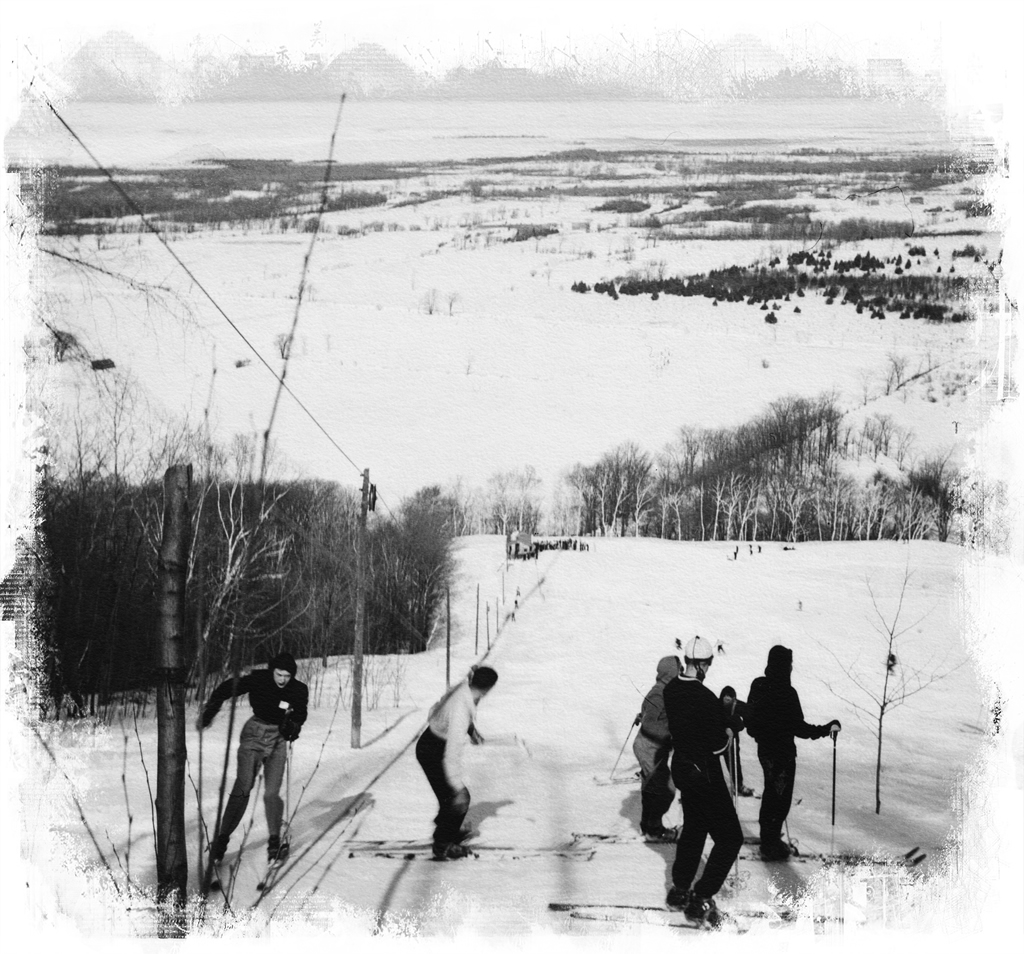
1951 – The rope tow on O-Hill
“The vertical drop (at Blue Mountain) is three miles wide.” `Jozo Weider
The impact that Blue Mountain Resorts has had on this region is immeasurable and there are countless stories and memories from ‘back in the day’. We spoke with four skiers who rode the original lifts at Blue and who knew Jozo Weider and his family. Their stories follow…
Shiela Metras remembers… When we were young, in the 1950s, we often skied on Friday nights at the barn hill. Jozo would start up the rope tow and we would ski for a few hours. One night, when there was a full moon, he decided to take us through the Apple Bowl orchard (yes, there was an orchard) from the barn hill to the Apple Bowl to ski. He started the 2 stage rope tow for us and we spent a magical night skiing by moonlight. It was very exciting as he had a few runs with us, and he was an amazing skier.
Earlier, we sometimes skied on the north side on Friday nights when the Collingwood Ski Club people would park their cars at the bottom of the Granny Hill and shine their lights up the hill so we could see. As a kid, I wasn’t strong enough to hold the rope tow line down and it would pick me up right off my feet. My strategy was to wait until a really big person came along to ride behind me. It was often Bill Stevenson or Harry Wilson (founders of Cranberry Resort) and they would always hold the rope down so I could get to the top in one piece. They were my favourite people.
In the spring, you could ski along the top of the hill, from the north side, over to the O-hill where the tow was only operated in the spring. At the end of the day, it was a long trek back along the bottom, but sometimes Jozo would bring the sleigh over and if you timed it right, you could ride back to the barn.
In the very late spring, a group of diehards—Don Macleod, George Weider, the Georgas brothers—to name a few, would gather on the V-Hill (now on Craigleith Ski club property) and we would climb up the 60 odd feet of snow left in the cleft of the hill and then ski down. We did this over and over until we were exhausted or it got dark. And that marked the end of the season.
Another day, another snowy adventure!
Sportswear and gear had a different vibe back in the day. Skis we’re made out of wood—by hand. Boots were uniformly made out of stiff (and soon-to-be frozen) leather. As the sport’s popularity spread so too did the evolution of ski fashion on-hill and off. “To relax before a fire after a day’s sport, bright coloured full skirts and slacks of velvet and gabardine were favourites. A fire red jersey, its basque jacket and swirling skirt quilted, won immediate approval.”
~ New York Times, Nov. 1948
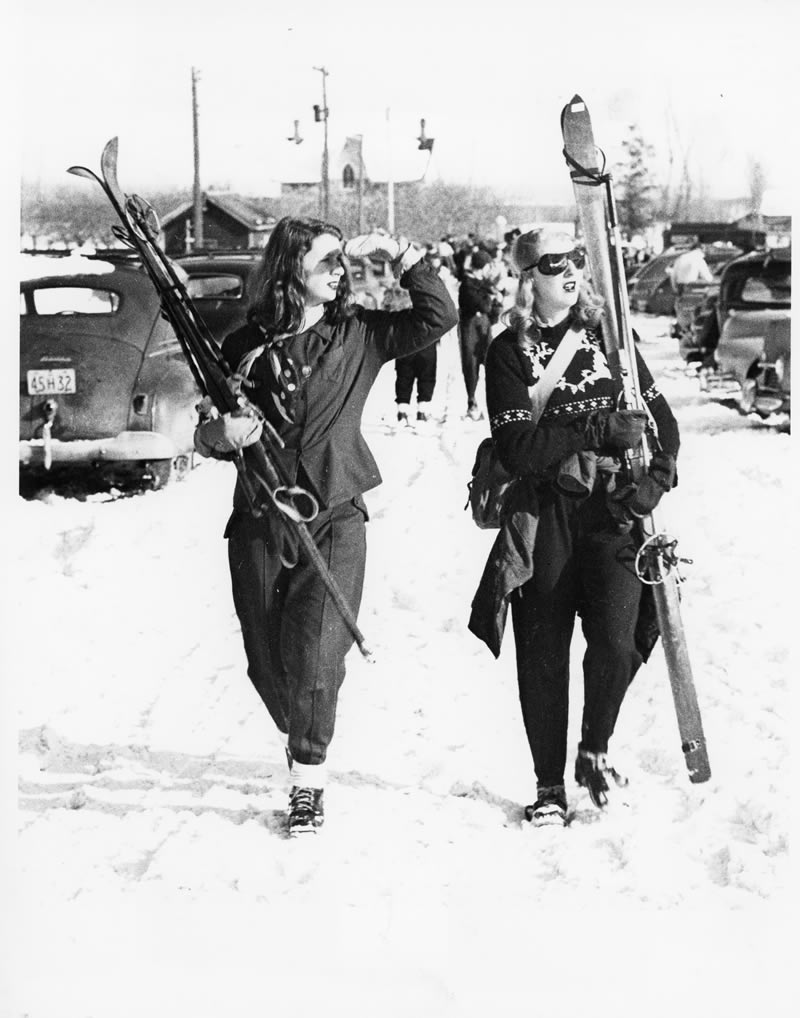
John Hethrington remembers…
In 1948 at age 12, I received my first membership badge for the Toronto Ski Club. In 1949 the Club bought 1 pair of jumping skis and sent Dave Palmateer and me to the Pete Petterson ski jumping school at Midland. During the winters of 1950 – 54, I raced for TSC at Blue Mountain with the Weider kids (Helen & George). Various adults like Dr. Doug Firth and Bob Gooch provided transportation from Toronto and I slept on any floor available at Blue.
In those years there were only 40 to 50 junior racers in Southern Ontario. Ellis Hazen, a high school teacher in Sudbury, would bring a bus load of junior racers from his Nickleteen Ski Club down to the Ontario Championships at Blue and regularly clean our clocks, particularly in the Nordic events. In those days, we raced all 4 events each weekend; downhill and slalom on Saturday—cross country and jumping on Sunday. Put that in your pipe and smoke it you spoiled kids of today. For races at Blue, Jozo made dinner plates painted with a ski racer, the winner’s name and the event and date. I still have 2 (my last name is spelled incorrectly).
Jozo financed the first Poma Lift in 1955 by selling books of 3-part Red tickets for $100 a book. I took my summer’s earnings that year and bought 3 books. How keen Is that? The irony is that the sons of the bankers who would not lend Jozo the money for a lift at Blue had founded Osler Bluffs Ski Club because of the long lines at Blue Mountain.
Pre-Bombardier snow packers, Jozo offered some of us free lift tickets if we packed the hills with snow shoes — we only did it a couple of times —too much work.
I remember the two rope tows at the North End. You leapt off one, two-thirds of the way up the hill and grabbed onto the second moving tow. In the spring, when the rope was so wet our mitts would slide, 5 of us at a time would hang on, and when they started up the tow, we would be showered with water and slush if we let it slip. I can just imagine what the safety people would say today.
I was a member of the University of Toronto 1955/56 ski team—that, for the one and only time, won the Canadian University Ski Championships. The team had a cabin up the hill from the Barn with no electricity or water. When we’d arrive at Blue Friday nights we had to haul all our stuff, including several cases of beer, up the hill. One Friday we found Jozo’s first, brand new, fiberglass Ski Patrol toboggan and used it to haul our stuff up the hill. After dinner (and the beer), we rode the toboggan down the hill and took out a fence post by the Barn—no damage to us as we rolled off, but the toboggan was split in two.
The same year I was coaching (taking care of) the TSC junior racers and they needed a place to stay at Blue, so we disassembled a garage on my father’s farm near Kleinburg, moved it to Blue Mountain and built a Junior Cabin up the hill from the barn. Eventually the TSC gave that cabin to Ross Larway, the past President of the TSC.
In 1961, when I was at Western, Jozo was my wintertime father—when I graduated with an MBA that spring, he tried to convince me to buy a lot at the bottom of the Apple Bowl for $500. “I can’t,” I said. I had a wife, a daughter and a new job with an ad agency in Montreal.
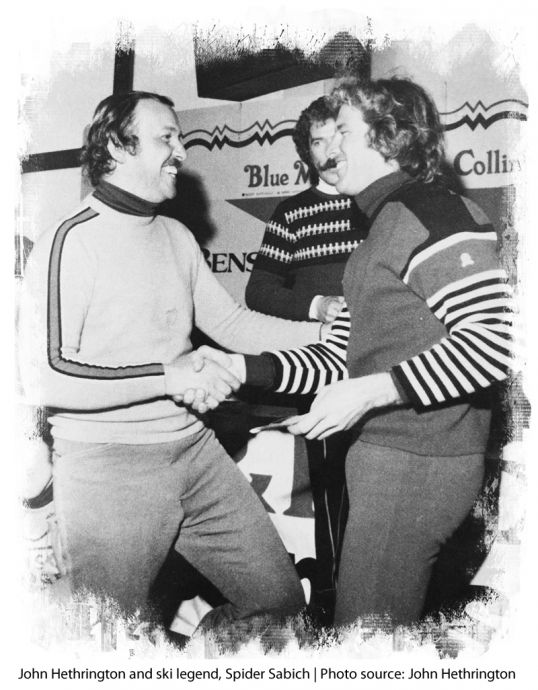 When we came back to Toronto in the spring of 1972, 6
When we came back to Toronto in the spring of 1972, 6
months after Jozo died, George Weider asked me to join the Blue Mountain board. I had just left one family company—Bombardier, where I was VP Marketing during the heyday of the Ski-Doo—to join the board of another family company in transition.
There are a series of “roll the dice and win” decisions of those days on the board I could tell you about as the resident outsider, the Slide Ride, taking over rentals and the shop from Ernie McCulloch and many more. We won them all.
Back in Toronto, I had a full time job as VP Marketing of Benson & Hedges Tobacco but did the marketing for Blue Mountain on the side. We developed the logo, still in use today and created the “Get Moving” notice boards to tell people the length of the lift lines at each tow to try and spread out the crowds. At the time there was not enough money to buy a new lift and we had to address the major complaint at Blue—lift lines—which was revealed through my market research surveys. At B&H I brought the Pro Ski Classic to Blue Mountain in 1972 with Spider Sabich and Jean Claude Killy after his 3 Olympic medals. Then after leaving B&H, I moved the event to become the Labatt Pro Ski Classic. There are some stories there.
As Gord Canning took over the role of President and George moved up to be Chairman, I retired from the board. Later I was asked back as a consultant when Blue was deciding what to do about their continuing inability to make Georgian Peaks a financial success. Blue purchased the Peaks in1980 and sold it in 1987 for the same price we paid for it. There’s a great Market Research story there.
I was with Gord and Kathy Canning on our way to Mont Tremblant for a Canadian Ski Association meeting, when we came up with the concept of the 5 x 7 ski pass at $79. They sold 10,000 the first year (2001). Over 700 people didn’t even show up to get the passes they had paid for. Gord offered to honour their passes the next year and built all kinds of goodwill, a concept that carried on Jozo’s tradition of putting the customer first, a tradition which continues to this day.
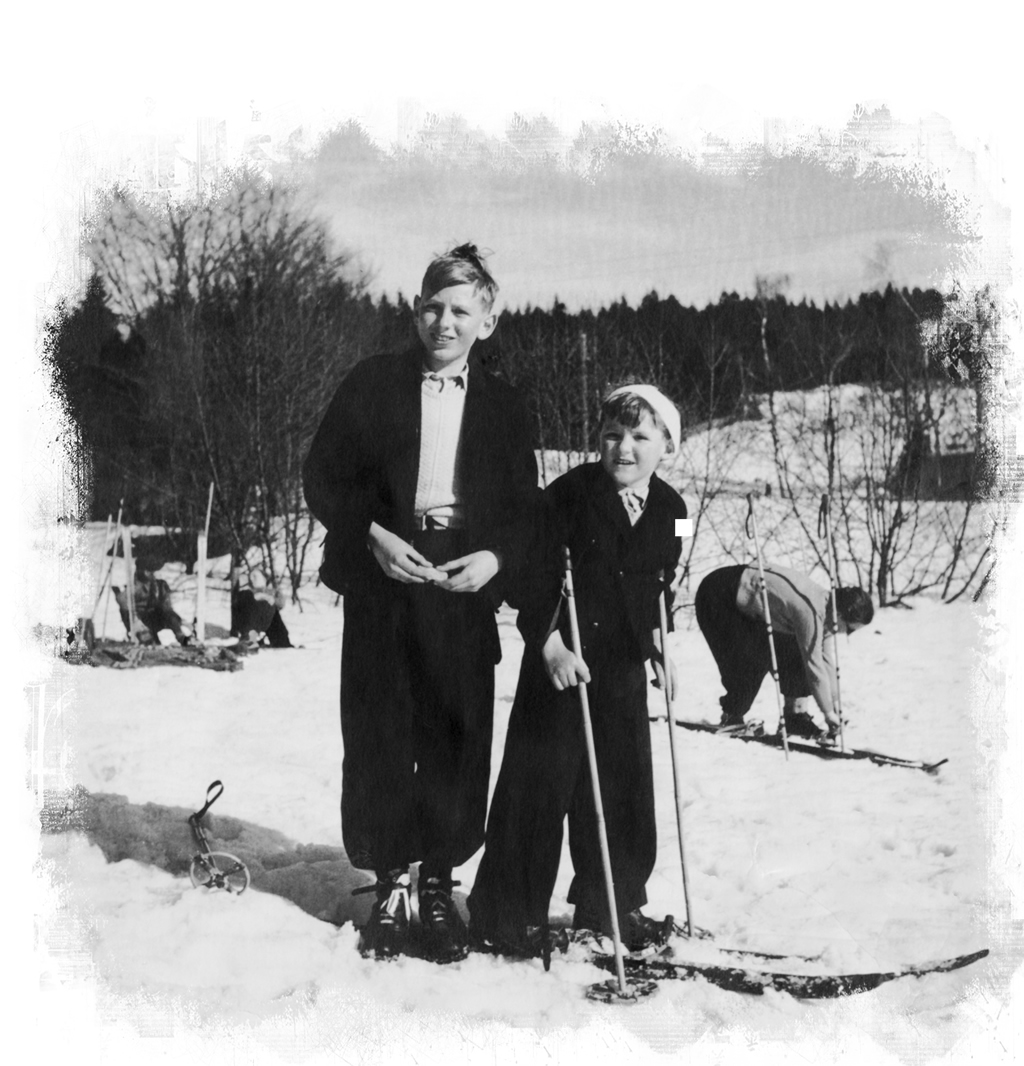
Bill (age 12) and Joe (age 5) Martinek | Courtesy: Brenda Martinek
In the early 1950s Albert and Mary Martinek along with their sons, Joseph and William, left their native Czechoslovakia for the slopes of Blue Mountain. With them they brought an artisan’s familiarity with Alpine Chalets, personal triumphs in Olympic ski competition and a European flair for good living. The family built their first chalet in the early 1960s at the base of Blue Mountain Resorts. Over the years, Joe and Bill continued to build and expand, creating Tyrolean Village Resorts, a thriving business that is still family owned and is now in the capable hands of Denis and Paul Martinek, sons of Brenda and Joe. Exciting growth continues.
Brenda Martinek remembers…
I first came to this area in 1964, looking for a chalet or old farmhouse to rent. It was on that visit that I met Joe Martinek at the Dorchester Hotel in Collingwood and we were married three months later.
Joe, Bill and their parents came to Canada in 1952 and ‘53, the boys first and then their parents. I believe Joe’s parents bought the 80 acres (Tyrolean Village Resorts) through power of sale in about 1956. The brothers started the plan of subdivision and roads in 1962. When I came on the scene there where 2 chalets almost finished, both being pan-abodes.
The Martineks met Jozo near the beginning of their involvement at Blue – they were all Czech. They were negotiating with Jozo about the water line when Jozo was killed in that horrific accident.
In my first year, I remember a poma lift at the north end of Toronto Ski Club and a T-bar on Apple Bowl. That first winter was a bad one for skiing—too mild—in those days before snow making, if the weather was warm and wet, there would be no skiing—just mud fields and Jozo would be scrambling around trying to come up with a solution. February was rainy that winter so we ended up skiing at Devil’s Glen because the snow lasted longer there.
As we expanded, we built eight tennis courts at Tyrolean Village and then in 1974, we put up the tennis bubble with two indoor courts. They were very busy but, expensive to build and expensive to maintain.
We needed gas running all the time to keep it up (inflated). There were a few disasters—when the power would go off—the bubble would come down and the lights would all crash down, smashed.
I took over managing the rentals in 1977. That was a crazy time—busy with my own kids while dealing with renters and complaints about noise along with everything else including police calls. I remember when a motorcycle gang arrived one summer. I always kept in touch with the local police if I knew bike gangs were coming but this time we didn’t know—some guy in a suit and tie had made the reservation and paid cash. Then they all arrived on their motorcycles, moved into three units and proceeded to completely trash them. We couldn’t see what was going on because the units they had rented backed onto the ravine. They threw all the furniture and anything wood—railings and such—out the back and had a huge bonfire. They burned it all. That was the end of the gangs. They never came back. That incident was the exception however, most of the renters were fine. I met a lot of great people.
In those years, Collingwood was still a ship building town. You’d drive down the main street and all you could see was a huge ship and the hotel on the right. They’d have a side-launch which was pretty amazing. Woolworths finally came in—big shopping in Collingwood. We always had a Fish & Chip or the Bamboo Terrace but we had to go to ‘The Depot’ in Craigleith if we were looking for “fine dining”.
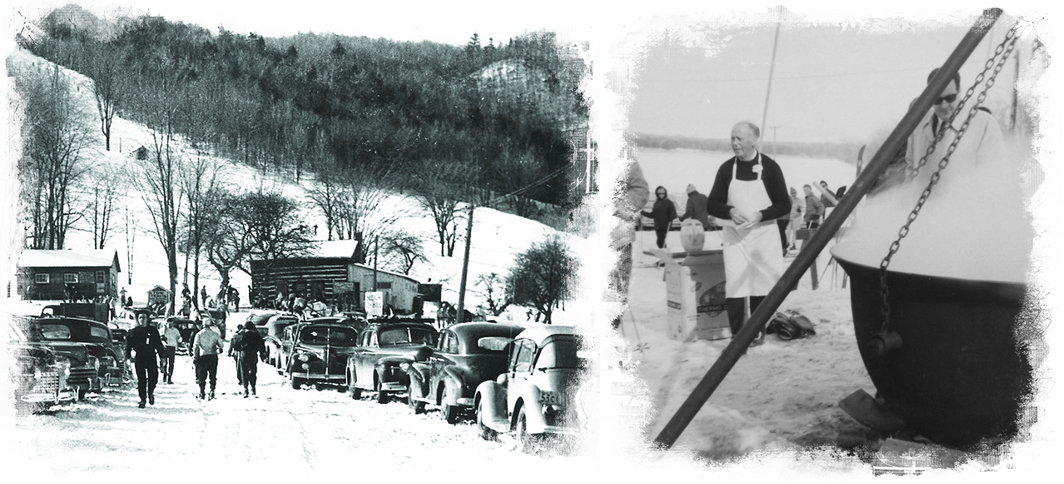
L – The North end – c. 1948 – Blue Mountain Ski Club’s log clubhouse is on the right and Morrill SkiShop sits on the left. | Courtesy: the Craigleith Heritage Depot, Blue Mountains Public Library.
R – Jozo offers Traditional Glühwein to skiers | Courtesy: Joanne Baker
Joanne Baker remembers…
My late husband Jerry Baker, first began to ski here when he was a teenager in high school. He would take the ski train from the city and then make his way up from the Depot to the base of the lifts. That’s how dedicated he was to skiing. Then he ended up with me who had never skied!
We moved here in 1969, when Jozo hired Jerry to work as the Advertising Sales Promotion Manager of Blue Mountain Resorts. When we first arrived, Jozo and his family had moved out of their old farmhouse. Jozo said “You come and live here”. With Jerry working for the resort, we always had lots of people coming to stay with us. It was almost like a hotel with skiers from all over. We loved living there but eventually outgrew it and built our own home up the hill.
I was just learning to ski so I got into lessons at the Toronto Ski Club. Those were the good old days—I had a lot of fun and met a lot of great people. I remember the North end with a rope tow up the Granny and a Poma lift up Schuss and Spec.
The ‘ski weekers’ would all stay at the Inn in those days and every Thursday night, Jerry and I would take them all over to the
Gateway in Collingwood for a wrap-up dinner and dance. It was a great time—everybody met everyone else and there were prizes for each ski school class. Larry Reid, who was manager of the Gateway at the time, prepared everything beautifully all winter.
I also remember days when Jozo would set up a gluvine pot at the south end so skiers could have a nice hot drink and a chat and a laugh or two before getting back on the lift. Jozo put a lot of effort into customer service and people seemed to really like it.
Jerry was supposed to go to Toronto with Jozo for a Toronto Ski Club meeting on that fateful night in 1971 when Jozo was killed in the car crash near Shelburne. At the time, Jerry was also the President of the Huronia Tourist Association and some kind of an emergency had come up so Jozo told Jerry to go to that meeting while Jozo drove alone to Toronto. That was a real shocker! Lots of changes happened after that.
Back in the early days, we got to know most of the regular skiers. Now you can get lost in the masses of people. The Toronto Ski Club has a reunion each year for those of us who have been members for 50 years or more. It’s fun to go and see people you haven’t seen in ages. Hardly any of us are skiing anymore but they’re dragging themselves there, whether it’s with walkers or canes or whatever.
Recently, while driving through Blue Mountain with my daughter Andrea and looking around at all the development, we agreed that this was Jerry’s dream. It had all come to be. |E|
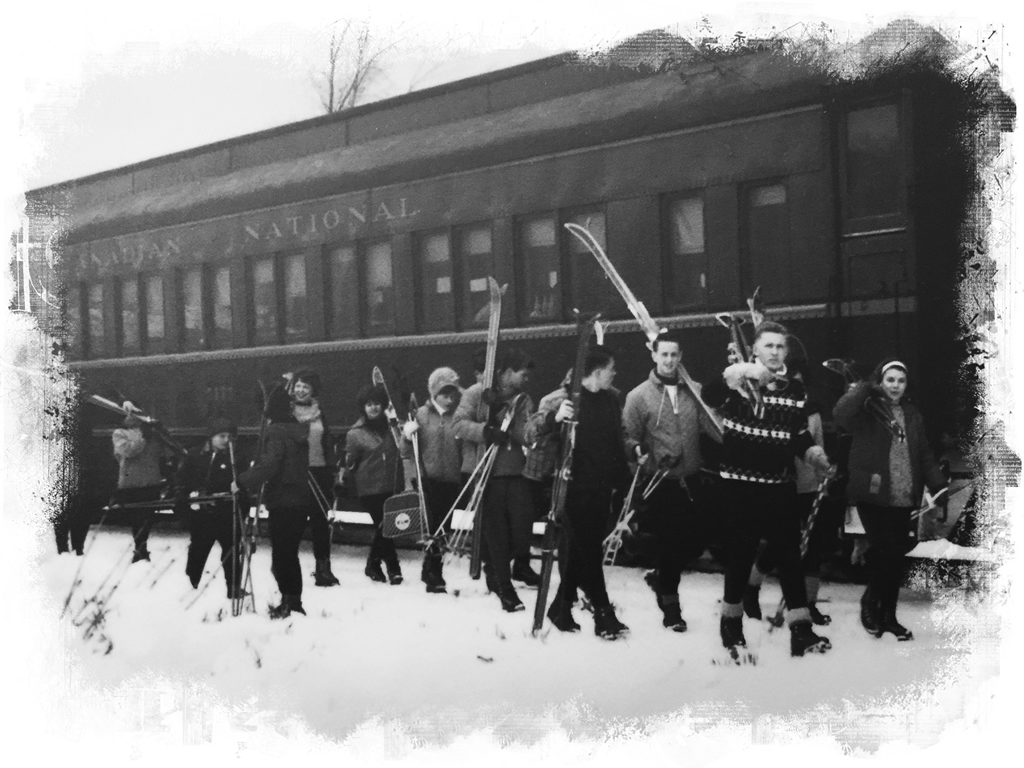
In 1941, Blue Mountain Special Ski Trains delivered 200-300 Toronto skiers to Craigleith station. | Courtesy: the Craigleith Heritage Depot, Blue Mountains Public Library.

